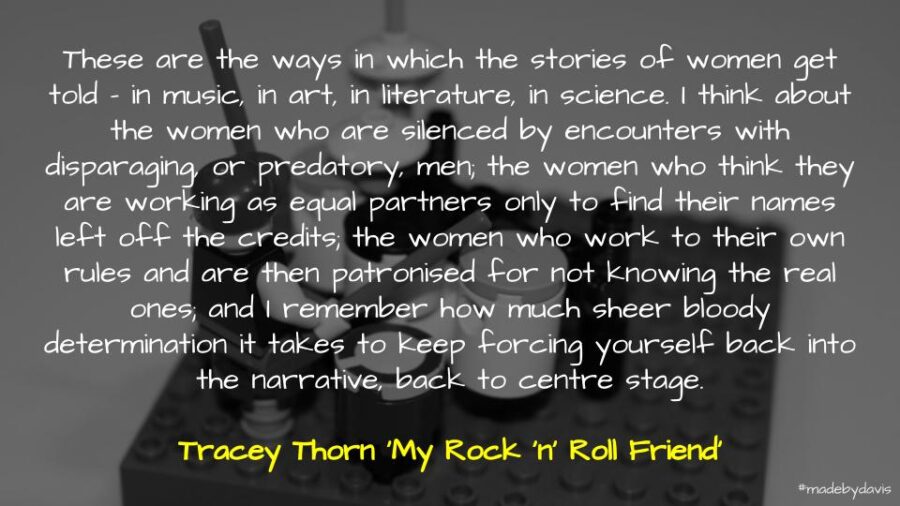My Rock ‘n’ Roll Friend is the story of Lindy Morrison told by Tracey Thorn. It is compiled from a range of sources, including interviews, letters between the two artists, diary entries provided by Morrison herself, as well as existing accounts of The Go-betweens, such as an interview with Andrew Denton and Kriv Stenders’ documentary Right Here.
On the one hand Thorn goes into Morrison’s life in The Go-Betweens as you would expect. However, she goes beyond the tales told by and about Robert Forster and Grant McLennan as ‘the indie Lennon and McCartney’ to provide a different perspective on how things were with an attempt to correct the record.
I have carried with me all the way through the writing of this book this particular line from Rebecca Solnit’s essay [Grandmother Spider] as a template for what I’ve tried to do, the way in which I want to reclaim Lindy’s story, to save it before it’s too late and to add it to all the other lost stories. To spin the web and not be caught in it, to create the world, to create your own life, to rule your own fate, to name the grandmothers as well as the fathers, to draw nets and not just straight lines, to be a maker as well as a cleaner, to be able to sing and not be silenced, to take down the veil and appear: all these are the banners on the laundry line I hang out. Why does it matter that Lindy has been partly written out of the story of the band? Because it happens all the time. LOCATION 2618
Thorn makes the claim that the band were always really a classic three-piece, with other members coming and going:
It is Lindy, Robert and Grant who are the original Go-Betweens. It is their band. In the future they might get in backing singers, or keyboard players, or violinists, or sax soloists, or a full-blown bloody orchestra, but the essence remains. They are a classic trio, whatever anyone might say later. LOCATION 485
Appealing to the reality beyond the myth surrounding Forster and McLennan’s friendship, Thorn suggests that denying Morrison’s contribution is the ‘final act of self-sabotage’.
Underplaying Lindy’s contribution does not just do her a disservice: it is self-defeating. It makes them a less interesting band, saddling them with a dull identity when they had a bright and interesting one. It is their final act of self-sabotage. LOCATION 2481
Thorn, also broadens out to provide a different perspective on Morrison, one that goes beyond the ‘force of nature’:
When it comes to describing you, everyone uses the same phrase: a force of nature. I do it myself in Bedsit Disco Queen: ‘as for Lindy, well, she was a sheer force of nature, an Amazonian blonde ten years older than me, unshockable, confrontational and loud’.
Your friend Marie Ryan says in the liner notes to a Go-Betweens box set: ‘She was a force of nature, brash, opinionated and loud.’
Writer Clinton Walker says: ‘Lindy, is, as we know, this force of nature, and she’s very attractive in that, you know, and she can be a FUCKING NIGHTMARE.’
Peter Walsh doesn’t use the actual phrase, but comes close:
Lindy Morrison. Her great, upending, tumultuous, machine-gun laugh . . . SHE SPOKE, IF NOT LIVED, EXCLUSIVELY IN CAPSLOCK, a Klieg light in a roomful of 40 watt bulbs. Describing her quickly exhausted all possible weather metaphors. Gales of laughter, gusts of enthusiasm, a storm of personality that broke in every room.
An interview in Hero magazine says: ‘Lindy Morrison is an excitable girl. Some would say volcanic.’ LOCATION: 924
Thorn explores Morrison’s life before The Go-Betweens, her discovery of feminism, work with Queensland Aboriginal and Torres Strait Islander Legal Service, relationships with Denis Walker, activism in Joh Bjelke-Petersen’s Queensland, participation in the world of theatre, hitching around Europe, and playing in punk group, Xero. However, most importantly, Thorn captures a more more human fragile side to Morrison, especially when exploring Morrison’s letters she used to write to herself when growing up.
When I learn about the child and teen she used to be, they are not immediately recognisable to me as the Lindy I thought I knew. The uncertainty, the self-doubt, the miseries suffered over her appearance – they’re at odds with my image of her. I had formed a first impression of her as a textbook heroine: a bold adventurer, no one’s plaything, no one’s victim. But I created that myself, out of almost nothing. LOCATION 1607
As Kitty Empire highlights, “this is a book about more than music.” It captures identity, friendship, culture, Gina Arnold suggests that, “the book is a reminder of the present, with Thorn using Morrison’s story to show the myriad ways that women continue to be underserved in the world of rock, despite being integral to it on every level.”
Listening to The Go-Betweens albums, I have always felt that they all seemed to lead to 16 Lovers Lane. However, after reading Thorn’s account, I have been left thinking that another way of viewing the before and after 16 Lovers Lane is a story of Lindy Morrison and everything that she brought to the ‘three piece’. I was also reminded about Ann Powers’ discussion of ‘band guys‘ wondering what she might add to this conversation.
Review: My Rock ‘n’ Roll Friend by Tracey Thorn by Aaron Davis is licensed under a Creative Commons Attribution-ShareAlike 4.0 International License.

Mentions